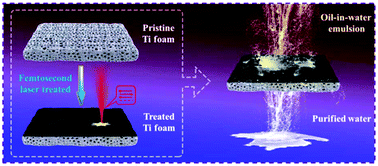Ultrafast nano-structuring of superwetting Ti foam with robust antifouling and stability towards efficient oil-in-water emulsion separation†
Abstract
Massive discharging of oily wastewater has a serious impact on the ecological environment and human health. However, the rapid development of an efficient separation membrane exhibiting anti-fouling and long-term stability for highly emulsified oily wastewater separation remains a challenge. Herein, a superwettable porous Ti foam was fabricated via a facile and ultrafast strategy of femtosecond laser direct writing. The obtained surface possessed numerous nanoparticle-covered nanoripple structures with intriguing superhydrophilicity and underwater superoleophobicity. Further, the laser-treated foam possessed high porosity and exhibited an excellent performance separating oil-in-water emulsions. A high permeation flux up to ∼1900 L m−1 h−1 was achieved, with a separation efficiency of >99% under a negative pressure (−5 kPa). Moreover, the as-prepared foam exhibited outstanding properties of anti-oil fouling and stability, indicating robust reusability for long-term separation application. This work may provide an efficient and low-cost route for overcoming future large-scale oily wastewater separation issues.

- This article is part of the themed collection: Nanoscale Most Popular Articles


 Please wait while we load your content...
Please wait while we load your content...